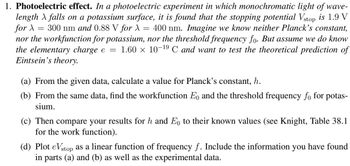Question

Transcribed Image Text:=
1. Photoelectric effect. In a photoelectric experiment in which monochromatic light of wave-
length \ falls on a potassium surface, it is found that the stopping potential Vstop is 1.9 V
for >
300 nm and 0.88 V for \ = 400 nm. Imagine we know neither Planck's constant,
nor the workfunction for potassium, nor the threshold frequency fo. But assume we do know
the elementary charge e 1.60 × 10-19 C and want to test the theoretical prediction of
Eintsein's theory.
=
(a) From the given data, calculate a value for Planck's constant, h.
(b) From the same data, find the workfunction Eo and the threshold frequency fo for potas-
sium.
(c) Then compare your results for h and Eo to their known values (see Knight, Table 38.1
for the work function).
(d) Plot eVstop as a linear function of frequency f. Include the information you have found
in parts (a) and (b) as well as the experimental data.
Expert Solution
This question has been solved!
Explore an expertly crafted, step-by-step solution for a thorough understanding of key concepts.
Step by stepSolved in 4 steps with 3 images

Knowledge Booster
Similar questions
- 11 The photoelectric effect explains The wave nature of light The particle nature of light The wave properties of an electron O The atomic structurearrow_forward8 : The moving electron and photon has same De Broglie wavelength. Show that the electron possesses more energy than carried by the photon,arrow_forwardIs there a use for the photoelectric effect in the real world?arrow_forward
- 41 The ratio of work function and threshold frequency is equal to * Velocity of light Thresh hold wavelength Planck's constant O K.E of photoelectronsarrow_forwardExplain the basic principle of photoelectron spectroscopyarrow_forward21. Which of the following processes cannot occur in empty space? photoelectric effect X-ray production compton scattering pair productionarrow_forward
- Q-23: What is common between Photoelectric effect and Compton effect with respect to nature of light.(*)arrow_forwardThe photoelectric emission could be explained by the ____________ a) Wave nature of light b) Particle nature of light c) Dual nature of light d) Quantum naturearrow_forwardWhat happens in the demonstration to show photoelectric emission?arrow_forward
arrow_back_ios
arrow_forward_ios